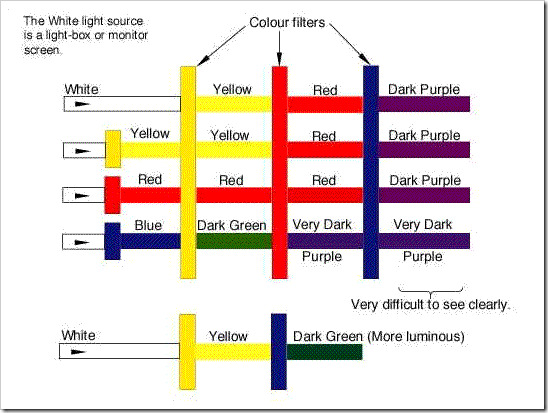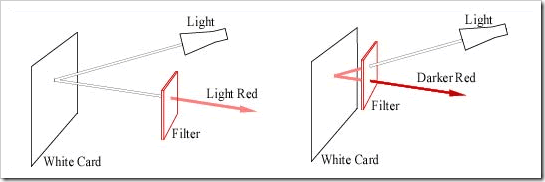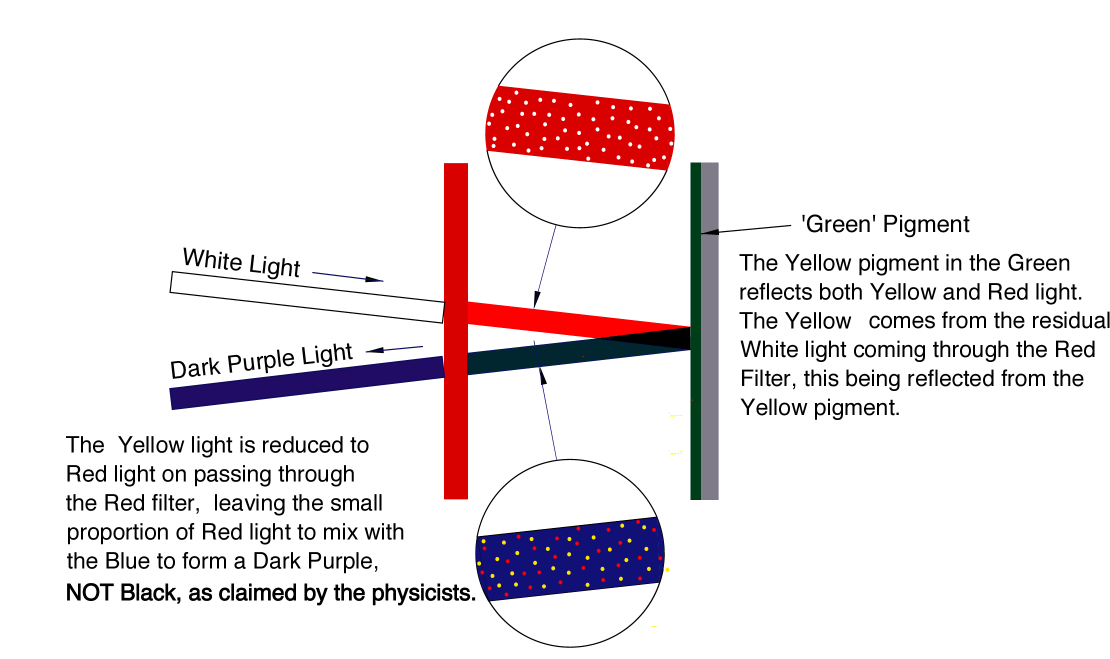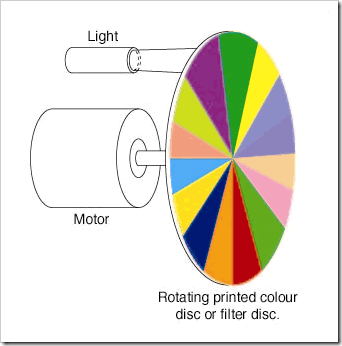-
Colour Filters- The Mechanics.
Posted on October 26th, 2009 No commentsPhysicists have never grasped the mechanics of colour or colour filters.
Most books on physics claim that Yellow is not a primary colour and that it is a combination of Green and Red light. This is based on the fact that both Yellow and Blue light will pass through a Green Filter. They say that Blue does not pass through a Red filter, which is untrue. They also claim that Red will not pass through a Blue filter, which is also untrue. In fact the filters reduce the energy of any light passing through them. White light passing through a Yellow filter will have its energy reduced into the Yellow range. The Red filter reduces the light into the Red range, and the Blue filter further reduces the light into the Blue range. The Yellow light exiting the Yellow filter carries some White light, the Red light exiting the Red filter carries some Yellow light and the Blue light exiting the Blue filter carries some Red light. The lower the energy of the light the easier it passes through a filter. White light passing through a Blue filter always gives you Blue plus White.
In the sketch below the Blue light passes through the yellow filter easily but the residual White from the Blue filter picks up some Yellow light, therefore creating a Dark Green. The higher energy Yellow is mostly reduced to Red while passing through the Red filter, leaving the lower energy Blue to pass through without difficulty.

Colour filters are not really filters they are optical resistances. They reduce the energy of light passing through them, they do not filter anything out of the light. A light beam loses energy by reflection and heat. A beam of White light striking the surface of a filter reflects a considerable amount of White light. The darker the filter, the greater the energy lost to reflection. A Dark Blue filter reflects almost White light, a Red filter reflects a bright Rose Pink, and a Yellow filter reflects a distinct Yellow. Energy is lost in the heating up of the filter itself, again the darker the colour the greater the heat loss.
Note: None of the ‘standard’ colours of pigments, or the RGB, CYMK, etc of monitors can produce the actual ‘true’ primary colours. The colours in the above drawing are only approximate. The closest are Red, Navy, and a slightly deeper version of the Yellow. With the addition of White and Black all other colours can be produced from these. See ‘Origin of Colour’
The colour of light passing through a filter depends on various conditions. It depends on the intensity of the light source and the colour of the light source. The simple experiment below demonstrates the type of logic error common in physics research. The left hand sketch shows white light reflected from a White card and then passing through a Red filter. Most people consider that if they lay a Red filter on a white board then the White light from the board shines through the filter in the same way as the left hand sketch. This is not true, because the light passing through the filter from the board is Red, not White, as indicated in the right hand sketch.

Why can a lower energy colour such as Blue pass easily through Red and Yellow filters, yet higher energy colours like Red and Yellow have difficulty passing through a Blue filter? The answer is simple mechanics.
The light passing through a filter may be compared with well-protected dodgem cars travelling along a wide highway that is scattered with large concrete blocks. The cars travelling at low speed will be able to negotiate these obstacles without mishap, and without much loss of speed. If the speed increases there will be collisions with the obstacles or other cars. The greater the speed, the greater the chance of collisions occurring. Comparing with light filters, the Blue filter would have many concrete blocks; Red would have less and Yellow even fewer.
It is obvious that the lower speed cars would have no difficulty passing through areas with fewer concrete blocks. This means that the cars (Particles) having the least energy have the least difficulty in passing through the obstacle course (Filter).
The interactions between cars (Particles) would be considerable, collisions causing some cars to accelerate and others to be slowed down, and some to be deflected off the side of the road (Heat emission). Some of the higher speed cars could pass through the area with little loss of speed, slight collisions with other cars deflecting them away from concrete blocks.
While on the subject of filters let us look at some others aspects of the physicists hypotheses on colour. Consider the arguments that White light is composed of all the other colours. This is on the basis that all other colours can be obtained from White light. This is a very weak hypothesis. If you have a 120 volt power supply you can obtain 100v, 24v, 12v, 6v, 3v or 1.5v from it. This does not mean that a 120 volt power supply is made up of all the lesser voltages.
As already shown you can obtain Red, Blue and Green light from Yellow light. This does not mean that Yellow light is made from Red, Blue and Green light.
The physicists statements that Blue light has the greatest energy is based on the illogical argument that “in a deep filter only Blue light passes through it and this proves that Blue light must have more energy.” Obviously they are forced to this conclusion by their conviction that White light is a combination of all the other colours. Using the same type of “logic” they could claim that as the water coming from the end of a 10km long x 25mm diameter. pipeline is only at a very low pressure, then this proves that only very low pressure water has the energy to travel this far!
Green Filters.
There are a lot of hits on the subject of Green filters. White light passing through a Green (mixed pigments of Yellow and Blue.) filter, results in a mixture of White, Yellow, Blue and normally a small amount of Red. (See Projected Light). The Red comes from a small amount of the Yellow light losing enough energy to fall into the Red range.
The colour seen through a filter depends on the make-up of the particular filter. If a green filter is a mixture of 10% Yellow and 90% Blue pigments, then approx. 10% of Yellow light will pass through. However, if the filter is 90% Yellow and 10% Blue then the light will probably contain a larger proportion of Red. The Yellow pigments will allow Yellow, Red and Blue light to pass through, the Blue pigments will only allow Blue light through, (With a touch of Red). This problem applies to all colour filters. A Royal Blue pigment is a mixture of Blue and Red pigments. Only by determining the basic ‘True Colours” can we create a scientific basis for colour, and form a common standard based on the actual physics of colour.
When considering colour filter set-ups it is essential to look at the mechanics of the system.
Consider where White light passes through a Red filter, reflects off a Green coloured board, and the board is viewed through the Red filter. The physicists argue that the Green is seen as Black through the Red filter. This is not so.
Green is a mixture ‘true’ Blue, (a very dark Blue), and ‘true’ Yellow, the actual shade depending on the relative proportions. The residual White light (See Projected Light) is reflected off the Green board as a mixture of ‘true’ Blue and ‘true’ Yellow light, and the Red light exiting the filter will be reflected off the Yellow pigment as Red and off the Blue pigment as Blue.. The Blue, on the second pass, will easily go through the Red filter but the Yellow light is mainly reduced into the Red range. We are therefore looking at a very dark Purple colour, which, under normal viewing conditions is easily mistaken for Black.

Reflected Green Light
If the Green is a light Green, this may because it has a greater proportion of Yellow pigment, or because it has a percentage of White pigment included. In this situation the Green board will appear to be a lighter purple.
A bit complicated, but mechanics is complicated, the main reason physicists can’t understand it.
Author, Brian Williams
GO TO “Master Page – Index” for related Colour posts that will help you to understand colour.
Technorati Tags: Colour Filters -
Newton’s Colour Wheel – The Reality
Posted on October 26th, 2009 No commentsModern physics considers that Newton’s rotating disc experiment proves that White light is composed of a combination of colours. The original experiment consisted of a rotating disc painted with various coloured sectors. As the speed increases the colours blur and become a greyish colour. The argument that this proves that White light is composed of the different colours is totally untrue. Most paints and dyes include white pigments to obtain the lighter shades. As the disc rotates the reflected light is a mixture of Blue, Red, Yellow and White light

The predominant pigment seen is White and this is seen for most of each rotation of the wheel. If 10 of the 15 sectors contain White pigment then White light will be seen for 2/3rds of each revolution.
If there are Red pigments in 5 of the 15 sectors then Red light will be seen for 1/3rd of each revolution. Similarly for Blue and Yellow pigments.
Also of importance is the relative energy of the reflected light. The White light has considerably more energy than the other colours and will therefore have a greater affect than just its relative proportion. Yellow will have a greater affect than Red or Blue, etc..
If we use a filter disc and shine a White light through it, we have a similar situation. Most filters allow some white light through them. In general therefore we will see White light for 100% of each revolution of the wheel. The points in the previous paragraphs also then apply.
The actual shades and percentages of pigmentation will determine the shade of ‘Grey’ seen.
If we had 25% each of Blue, Red, Yellow and White pigments, then the reflective energy of the 25% White would probably be greater than the combined energies of the other colours.
Note that what if we look at a sheet of ‘White’ paper whilst inside a well lit room, it reflects only about 10% of the energy that it would if viewed outside on an overcast day. It still appears to be White in both locations.
The retinal cones are also confused by the constant colour changes above 16 changes per second. The relative constancy of the White during each revolution allows the cones to easily identify White.
Although normally used to ‘obtain’ varying shades of Gray, the colour wheel can be used to produce any colour by using only White, Yellow, Red, Dark Blue and Black sectors in varying proportions.
If the wheel only has Yellow and Blue pigment sectors or filters the colour seen is Green, therefore ‘proving’ that Green light is composed of Yellow and Blue light. If you only use Red and Green on the wheel you get Gray/Khaki, not Yellow as argued by the physicists. This is using the same principles/hypotheses as the physics establishment.
However, if you force (Yellow + Blue) = Green + Red into the same space the total energy (Speed) increases into the Yellow range or even sometimes into White. Basic Fluid mechanics.
Author.-Brian Williams
See An Introduction to Colour for further information.
See also Projected Light , Colour and the Prism andTechnorati Tags: Newton’s Colour Wheel -
The Origin of Colour – New Research
Posted on July 3rd, 2009 No commentsThe retinal cones can differentiate 4 different energy/velocity ranges which the brain interprets as the colours Blue, Red, Yellow and White. Light ‘particles’ entering the cone and having sufficient energy to pass through to the 4th compartment are assessed by the brain to be ‘White’ light. Any light passing into the 1st compartment but without sufficient energy to pass into the second will be assessed as ‘Blue’ light. Similarly with the ‘Red” and ‘Yellow’ compartments.
 Although this may appear to be too simple to explain the wide range of colours and shades, in fact it explains all of them. It also provides the explanation of ‘Colour Blindness’, which I considered essential to any theory of colour. Yes I am aware that the above simplified version of the retinal cone is very little like a real retinal cone. The real cone is a very messy looking unit that could do with a bit of engineering updating, but it does do what it was designed to do. Although the shapes and sizes of individual cones may widely vary, the human brain can adjust the information in the same way that a good pianist can play a badly tuned piano.
Although this may appear to be too simple to explain the wide range of colours and shades, in fact it explains all of them. It also provides the explanation of ‘Colour Blindness’, which I considered essential to any theory of colour. Yes I am aware that the above simplified version of the retinal cone is very little like a real retinal cone. The real cone is a very messy looking unit that could do with a bit of engineering updating, but it does do what it was designed to do. Although the shapes and sizes of individual cones may widely vary, the human brain can adjust the information in the same way that a good pianist can play a badly tuned piano.
Colours as Perceived by the Eye and Brain
The addition of two colours of different energy levels creates turbulence in the ‘cones’. Where Blue and White are mixed as in Cyan, Bright Green and Magenta Pinks, this creates the greatest turbulence which is irritating to the eye. Lesser energy differentials such as Yellow and Blue (as in the natural Greens) give a more gentle turbulence which is soothing to the eye. It should be realised that the ‘True’ Primary colours actually cover a range of energy levels, i.e. in the ‘true’ Red above the range is shown as 20-69 (hypothetical energy units). This means that light having energy in this range will be perceived as ‘true’ Red. Colour ‘Blindness’ is due to either chemical differences in the cone fluid altering the resistance to the passage of light and therefore changing the section of the cone into which it finally arrives, or may be due to actual physical differences in the cones. The effect of the actual energy level will only become apparent when combined/mixed with other Primary colours. It should be realised that the ‘Wave Hypothesis of Light’ is unable to explain any of the colour phenomena, because the mixing or combining of colours would destroy any ‘frequency’ involved in light. There is also the fact that the eye is confused by frequencies above 15-20 cycles/sec, yet the physicists argue that the eye operates at approx 10,000,000,000,000,000 cycles/sec. See also Newton’s Colour Wheel, Taper Slit Experiment, Taper Silhouette Experiment. First published July 3rd 2009
Brian Williams – Author

